Leadership
July 30, 2025
5
Min
Creative Destruction: A Thinking Habit for Entrepreneurs
Creative Thinking
|
What if the thing holding your business back is the very thing that made it successful?
It’s a confronting thought, but one we’ve seen play out time and again. A company clings to its golden goose - a product line, a pricing model, a process - long after its prime. Innovation stalls. Margins shrink. Competitors overtake. Why? Because destruction feels like failure. But for entrepreneurs, it’s often the first act of renewal.
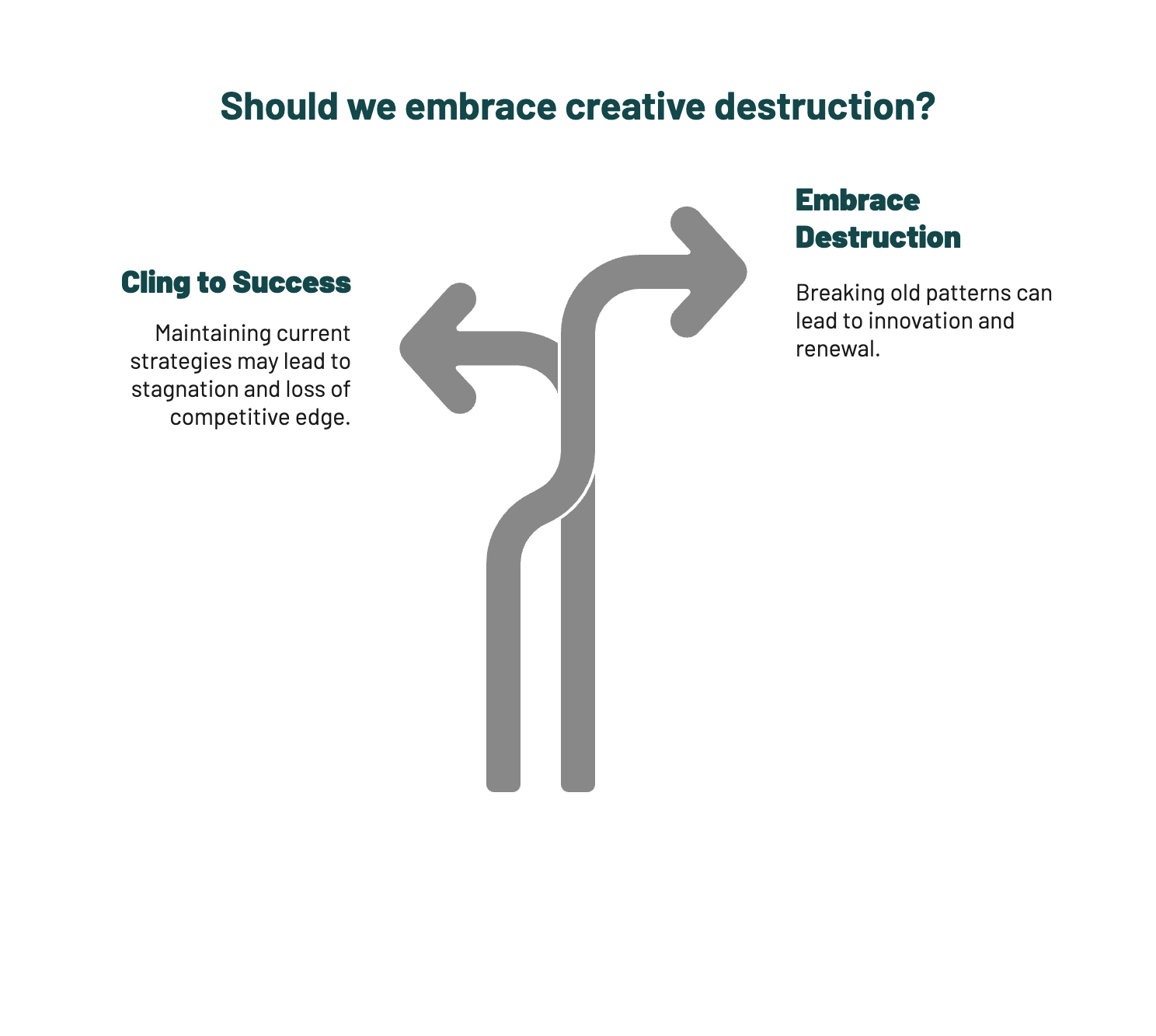
Joseph Schumpeter coined the term “creative destruction” in the 1940s to describe how capitalism evolves - not gradually, but through waves of disruption that destroy the old to make space for the new.
Today, that wave is more like a torrent. In 2023, over 50% of S&P 500 companies reported active business model reinvention efforts. AI is rewriting value chains. Consumer expectations are in flux. And barriers to entry in most industries have crumbled.
For entrepreneurs, this isn’t a threat. It’s oxygen.
But only if we train ourselves to think destructively - not with chaos, but with clear intent.
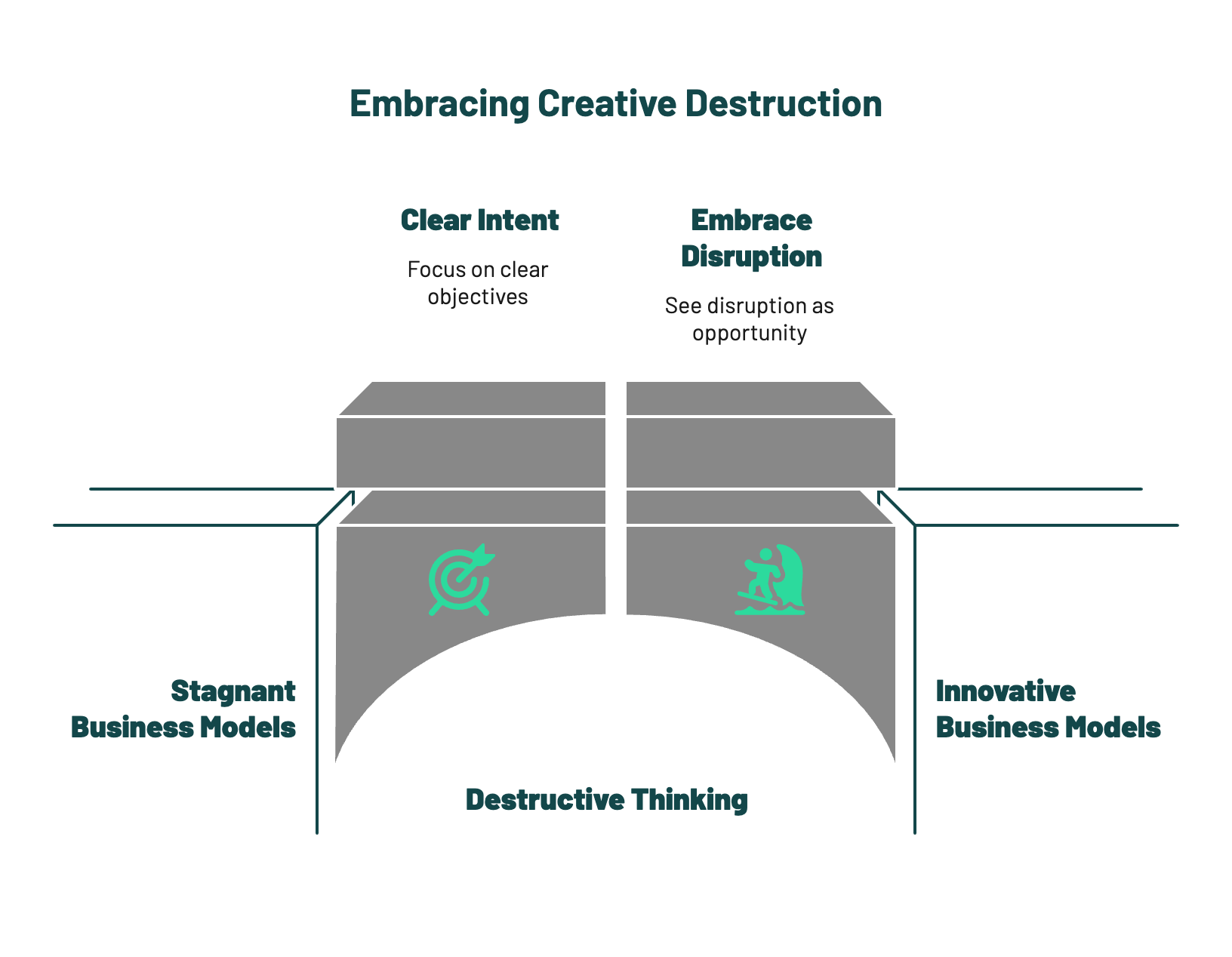
We call it The Builder’s Paradox Loop: the discipline of intentionally dismantling what works... before it stops working.
Every business has them: unspoken assumptions or "non-negotiables" that were once brilliant but are now baggage.
Identifying these is the first act of rebellion. It requires candour and detachment. What got you here may not get you there.
Reflection Prompt:
What would we never question in our business - and what if we did?
Micro-action:
Run a “Zero-Based Strategy” meeting. Assume nothing. Justify everything.
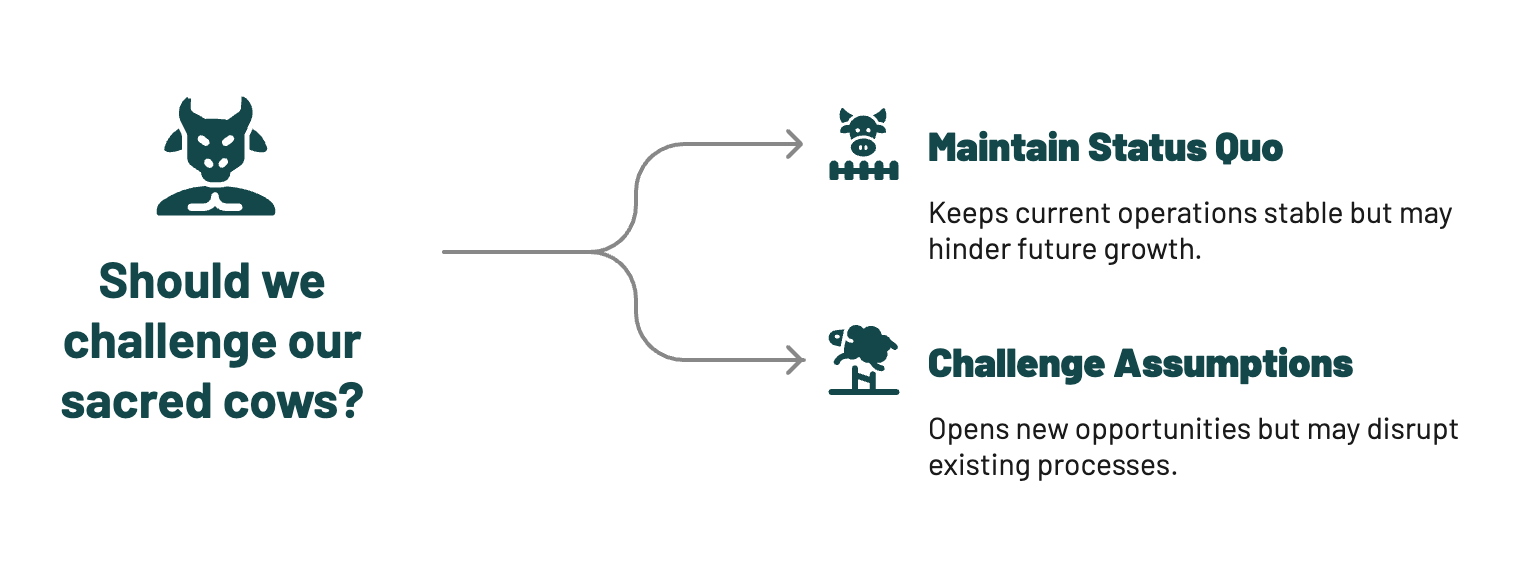
Too often, entrepreneurs fixate on beating their current competitors. But in creative destruction, your real enemy is obsolescence.
Don’t just ask, “Who’s eating our lunch?”
Ask, “What could make all of us irrelevant?”
This shift sharpens your radar for disruptive forces - technologies, business models, distribution hacks - that haven’t yet entered your lane... but could.
Example:
A regional logistics firm stopped benchmarking against local players and started studying Amazon’s last-mile automation and vertical integration. Within a year, they built a profitable micro-fulfilment division that pre-empted disintermediation.
Micro-action:
Once a quarter, assign someone on your team to be “Chief Disruptor.” Their job: pitch one scenario where your business loses 80% of its value.
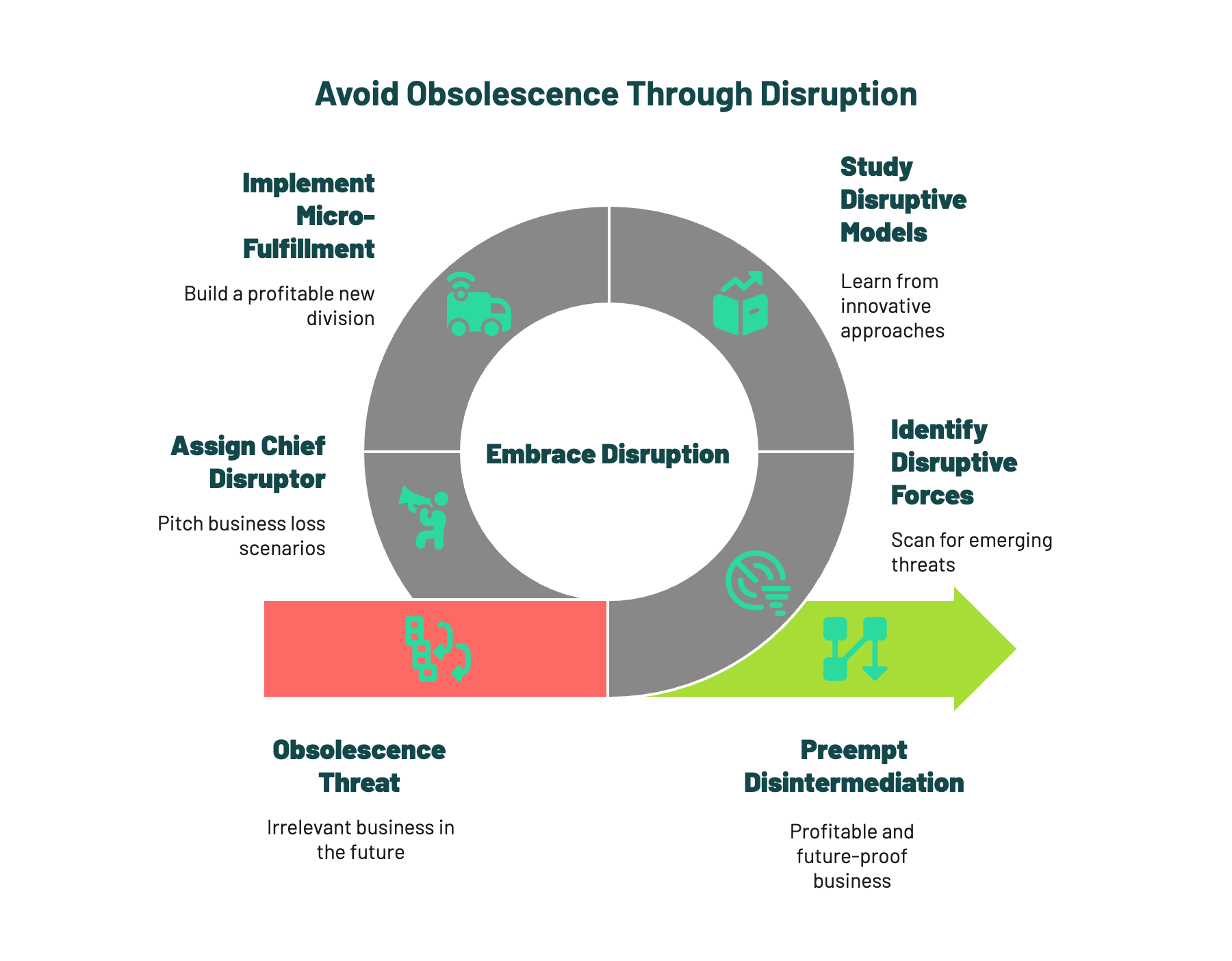
Destruction doesn’t have to start at scale. The smartest entrepreneurs test what’s threatening their model - by trying it themselves.
Launch a rival brand. Sell direct if you’ve always used resellers. Offer a free version that eats into your margins. These “Trojan pilots” reveal whether the threat is real... and whether it could become your next growth engine.
Pro Tip:
Use different branding and isolated channels to avoid brand confusion or cannibalisation fears during early tests.
Micro-action:
Design a 6-week “Kill Our Model” experiment. What’s one radical variant of your offer that your current business would hate - and your future customer might love?
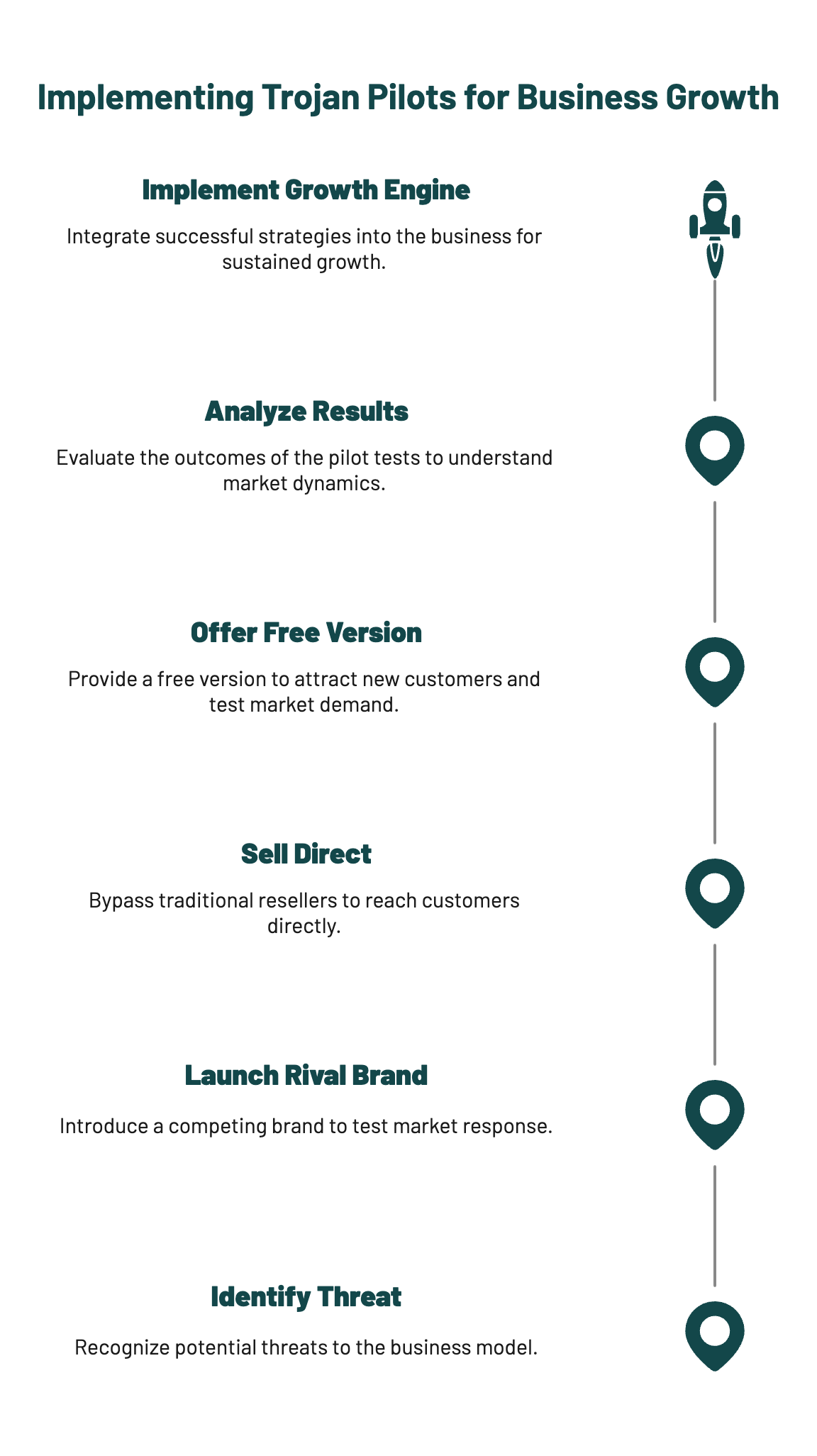
As counterintuitive as it sounds, sustainable businesses are built on flexible scaffolding, not permanent pillars.
Create living documents that capture your evolving strategy assumptions - and set review cycles to revisit them. Train teams to treat processes as disposable and purpose as enduring.
Example:
One startup we advised included “Shed What No Longer Serves” as a quarterly team ritual. Anything could be nominated: a product, a process, even a belief. The only rule? It had to spark growth if let go.
Micro-action:
Draft a “Destructible Dozen” - 12 elements of your current business you’re willing to kill, change, or rewrite if the right opportunity presents itself.
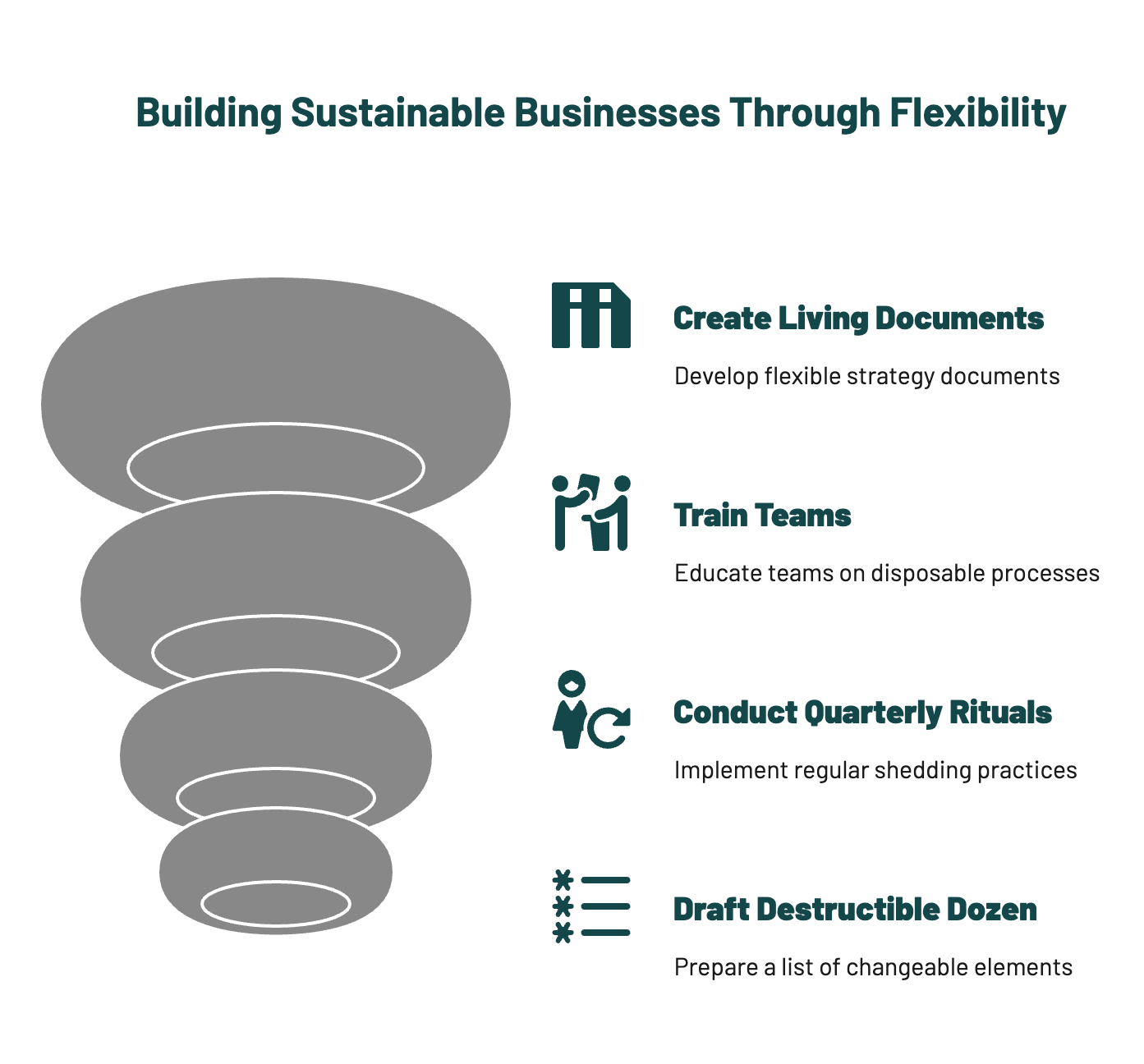
Creative destruction doesn’t live in brainstorms. It lives in the operating rhythm.
Here’s how to embed it:
Pro Tip:
If your org treats change as shameful, no one will suggest it. Culture has to celebrate strategic subtraction.
Through coaching founders and growth-stage teams, we’ve seen four recurring traps:
Build the muscle of temporary permanence. Everything lasts - until it doesn’t. What matters is how quickly you’re willing to update the frame.
Prompt 1: What’s one aspect of your current success that feels most dangerous to challenge - and what would it take to test that assumption safely?
Prompt 2: Imagine your fiercest competitor has tripled their growth in the last year. What did they destroy that you didn’t?
Leaders who make creative destruction a habit don’t just innovate. They compound.
They’re faster at pivots, clearer on strategy, and braver in decision-making. Teams feel freer to suggest bold ideas. Customers sense forward momentum. And investors trust that reinvention is built into the system - not forced upon it during crisis.
It’s not just a mindset. It’s an edge.
Choose one thing this week to deconstruct. A process. A belief. A product. Don’t just tweak. Rethink. And involve your team - creative destruction thrives in the open.
Let us know what you decided to challenge. We’d love to hear your story.
Team SHIFT
Why the best builders are sometimes the best breakers, too
What if the thing holding your business back is the very thing that made it successful?
It’s a confronting thought, but one we’ve seen play out time and again. A company clings to its golden goose - a product line, a pricing model, a process - long after its prime. Innovation stalls. Margins shrink. Competitors overtake. Why? Because destruction feels like failure. But for entrepreneurs, it’s often the first act of renewal.

Joseph Schumpeter coined the term “creative destruction” in the 1940s to describe how capitalism evolves - not gradually, but through waves of disruption that destroy the old to make space for the new.
Today, that wave is more like a torrent. In 2023, over 50% of S&P 500 companies reported active business model reinvention efforts. AI is rewriting value chains. Consumer expectations are in flux. And barriers to entry in most industries have crumbled.
For entrepreneurs, this isn’t a threat. It’s oxygen.
But only if we train ourselves to think destructively - not with chaos, but with clear intent.

We call it The Builder’s Paradox Loop: the discipline of intentionally dismantling what works... before it stops working.
Every business has them: unspoken assumptions or "non-negotiables" that were once brilliant but are now baggage.
Identifying these is the first act of rebellion. It requires candour and detachment. What got you here may not get you there.
Reflection Prompt:
What would we never question in our business - and what if we did?
Micro-action:
Run a “Zero-Based Strategy” meeting. Assume nothing. Justify everything.

Too often, entrepreneurs fixate on beating their current competitors. But in creative destruction, your real enemy is obsolescence.
Don’t just ask, “Who’s eating our lunch?”
Ask, “What could make all of us irrelevant?”
This shift sharpens your radar for disruptive forces - technologies, business models, distribution hacks - that haven’t yet entered your lane... but could.
Example:
A regional logistics firm stopped benchmarking against local players and started studying Amazon’s last-mile automation and vertical integration. Within a year, they built a profitable micro-fulfilment division that pre-empted disintermediation.
Micro-action:
Once a quarter, assign someone on your team to be “Chief Disruptor.” Their job: pitch one scenario where your business loses 80% of its value.

Destruction doesn’t have to start at scale. The smartest entrepreneurs test what’s threatening their model - by trying it themselves.
Launch a rival brand. Sell direct if you’ve always used resellers. Offer a free version that eats into your margins. These “Trojan pilots” reveal whether the threat is real... and whether it could become your next growth engine.
Pro Tip:
Use different branding and isolated channels to avoid brand confusion or cannibalisation fears during early tests.
Micro-action:
Design a 6-week “Kill Our Model” experiment. What’s one radical variant of your offer that your current business would hate - and your future customer might love?

As counterintuitive as it sounds, sustainable businesses are built on flexible scaffolding, not permanent pillars.
Create living documents that capture your evolving strategy assumptions - and set review cycles to revisit them. Train teams to treat processes as disposable and purpose as enduring.
Example:
One startup we advised included “Shed What No Longer Serves” as a quarterly team ritual. Anything could be nominated: a product, a process, even a belief. The only rule? It had to spark growth if let go.
Micro-action:
Draft a “Destructible Dozen” - 12 elements of your current business you’re willing to kill, change, or rewrite if the right opportunity presents itself.

Creative destruction doesn’t live in brainstorms. It lives in the operating rhythm.
Here’s how to embed it:
Pro Tip:
If your org treats change as shameful, no one will suggest it. Culture has to celebrate strategic subtraction.
Through coaching founders and growth-stage teams, we’ve seen four recurring traps:
Build the muscle of temporary permanence. Everything lasts - until it doesn’t. What matters is how quickly you’re willing to update the frame.
Prompt 1: What’s one aspect of your current success that feels most dangerous to challenge - and what would it take to test that assumption safely?
Prompt 2: Imagine your fiercest competitor has tripled their growth in the last year. What did they destroy that you didn’t?
Leaders who make creative destruction a habit don’t just innovate. They compound.
They’re faster at pivots, clearer on strategy, and braver in decision-making. Teams feel freer to suggest bold ideas. Customers sense forward momentum. And investors trust that reinvention is built into the system - not forced upon it during crisis.
It’s not just a mindset. It’s an edge.
Choose one thing this week to deconstruct. A process. A belief. A product. Don’t just tweak. Rethink. And involve your team - creative destruction thrives in the open.
Let us know what you decided to challenge. We’d love to hear your story.
Team SHIFT
Why the best builders are sometimes the best breakers, too
What if the thing holding your business back is the very thing that made it successful?
It’s a confronting thought, but one we’ve seen play out time and again. A company clings to its golden goose - a product line, a pricing model, a process - long after its prime. Innovation stalls. Margins shrink. Competitors overtake. Why? Because destruction feels like failure. But for entrepreneurs, it’s often the first act of renewal.

Joseph Schumpeter coined the term “creative destruction” in the 1940s to describe how capitalism evolves - not gradually, but through waves of disruption that destroy the old to make space for the new.
Today, that wave is more like a torrent. In 2023, over 50% of S&P 500 companies reported active business model reinvention efforts. AI is rewriting value chains. Consumer expectations are in flux. And barriers to entry in most industries have crumbled.
For entrepreneurs, this isn’t a threat. It’s oxygen.
But only if we train ourselves to think destructively - not with chaos, but with clear intent.

We call it The Builder’s Paradox Loop: the discipline of intentionally dismantling what works... before it stops working.
Every business has them: unspoken assumptions or "non-negotiables" that were once brilliant but are now baggage.
Identifying these is the first act of rebellion. It requires candour and detachment. What got you here may not get you there.
Reflection Prompt:
What would we never question in our business - and what if we did?
Micro-action:
Run a “Zero-Based Strategy” meeting. Assume nothing. Justify everything.

Too often, entrepreneurs fixate on beating their current competitors. But in creative destruction, your real enemy is obsolescence.
Don’t just ask, “Who’s eating our lunch?”
Ask, “What could make all of us irrelevant?”
This shift sharpens your radar for disruptive forces - technologies, business models, distribution hacks - that haven’t yet entered your lane... but could.
Example:
A regional logistics firm stopped benchmarking against local players and started studying Amazon’s last-mile automation and vertical integration. Within a year, they built a profitable micro-fulfilment division that pre-empted disintermediation.
Micro-action:
Once a quarter, assign someone on your team to be “Chief Disruptor.” Their job: pitch one scenario where your business loses 80% of its value.

Destruction doesn’t have to start at scale. The smartest entrepreneurs test what’s threatening their model - by trying it themselves.
Launch a rival brand. Sell direct if you’ve always used resellers. Offer a free version that eats into your margins. These “Trojan pilots” reveal whether the threat is real... and whether it could become your next growth engine.
Pro Tip:
Use different branding and isolated channels to avoid brand confusion or cannibalisation fears during early tests.
Micro-action:
Design a 6-week “Kill Our Model” experiment. What’s one radical variant of your offer that your current business would hate - and your future customer might love?

As counterintuitive as it sounds, sustainable businesses are built on flexible scaffolding, not permanent pillars.
Create living documents that capture your evolving strategy assumptions - and set review cycles to revisit them. Train teams to treat processes as disposable and purpose as enduring.
Example:
One startup we advised included “Shed What No Longer Serves” as a quarterly team ritual. Anything could be nominated: a product, a process, even a belief. The only rule? It had to spark growth if let go.
Micro-action:
Draft a “Destructible Dozen” - 12 elements of your current business you’re willing to kill, change, or rewrite if the right opportunity presents itself.

Creative destruction doesn’t live in brainstorms. It lives in the operating rhythm.
Here’s how to embed it:
Pro Tip:
If your org treats change as shameful, no one will suggest it. Culture has to celebrate strategic subtraction.
Through coaching founders and growth-stage teams, we’ve seen four recurring traps:
Build the muscle of temporary permanence. Everything lasts - until it doesn’t. What matters is how quickly you’re willing to update the frame.
Prompt 1: What’s one aspect of your current success that feels most dangerous to challenge - and what would it take to test that assumption safely?
Prompt 2: Imagine your fiercest competitor has tripled their growth in the last year. What did they destroy that you didn’t?
Leaders who make creative destruction a habit don’t just innovate. They compound.
They’re faster at pivots, clearer on strategy, and braver in decision-making. Teams feel freer to suggest bold ideas. Customers sense forward momentum. And investors trust that reinvention is built into the system - not forced upon it during crisis.
It’s not just a mindset. It’s an edge.
Choose one thing this week to deconstruct. A process. A belief. A product. Don’t just tweak. Rethink. And involve your team - creative destruction thrives in the open.
Let us know what you decided to challenge. We’d love to hear your story.
Team SHIFT
